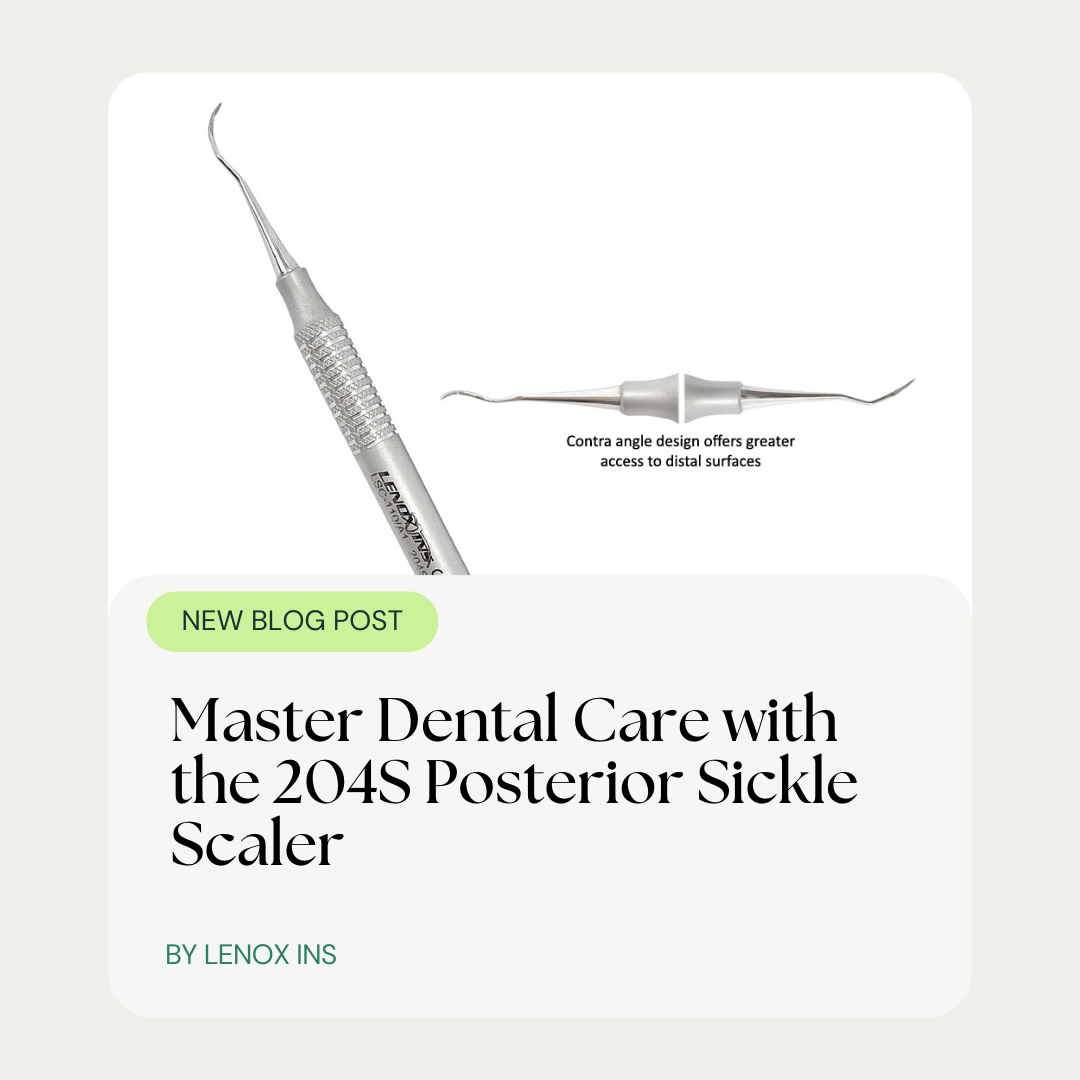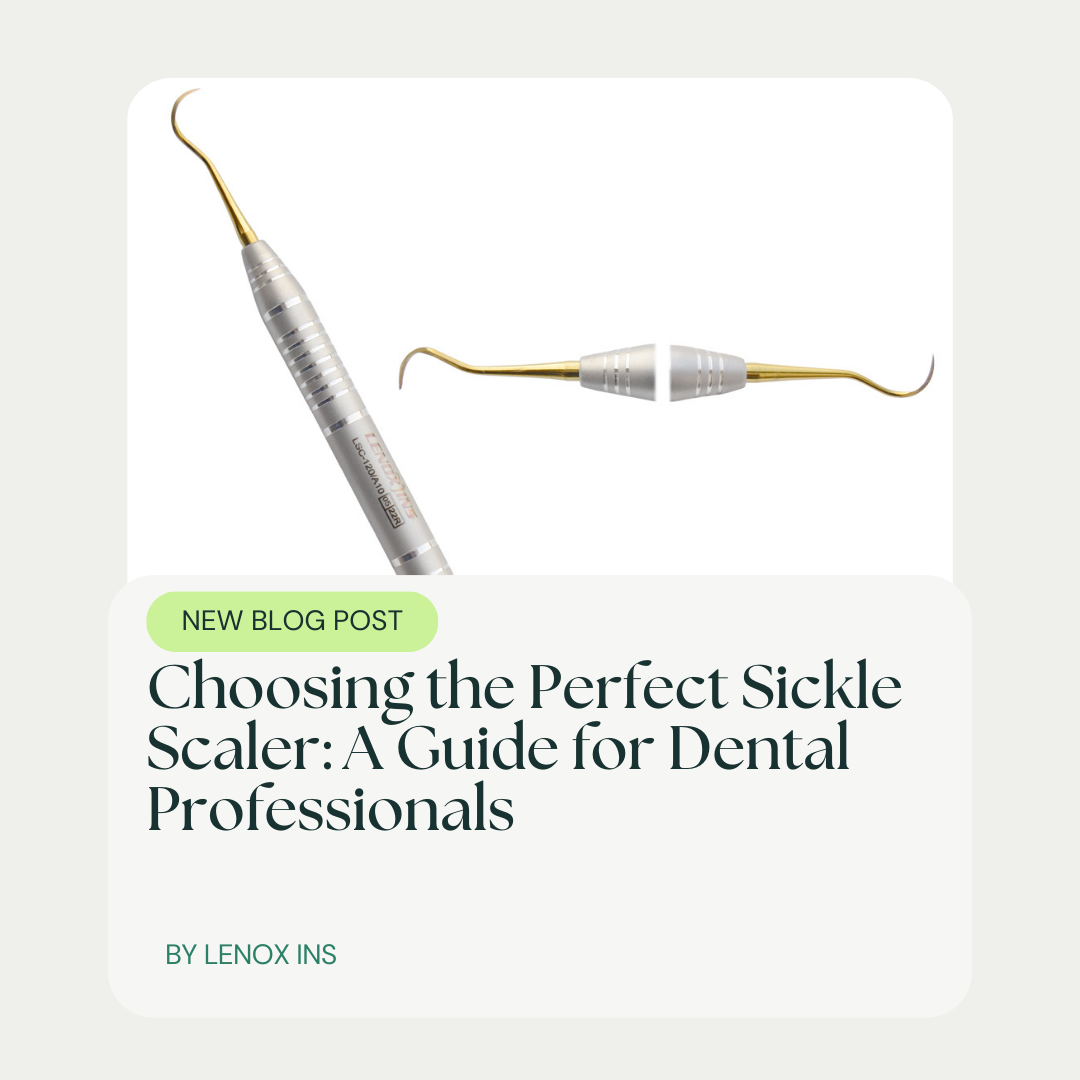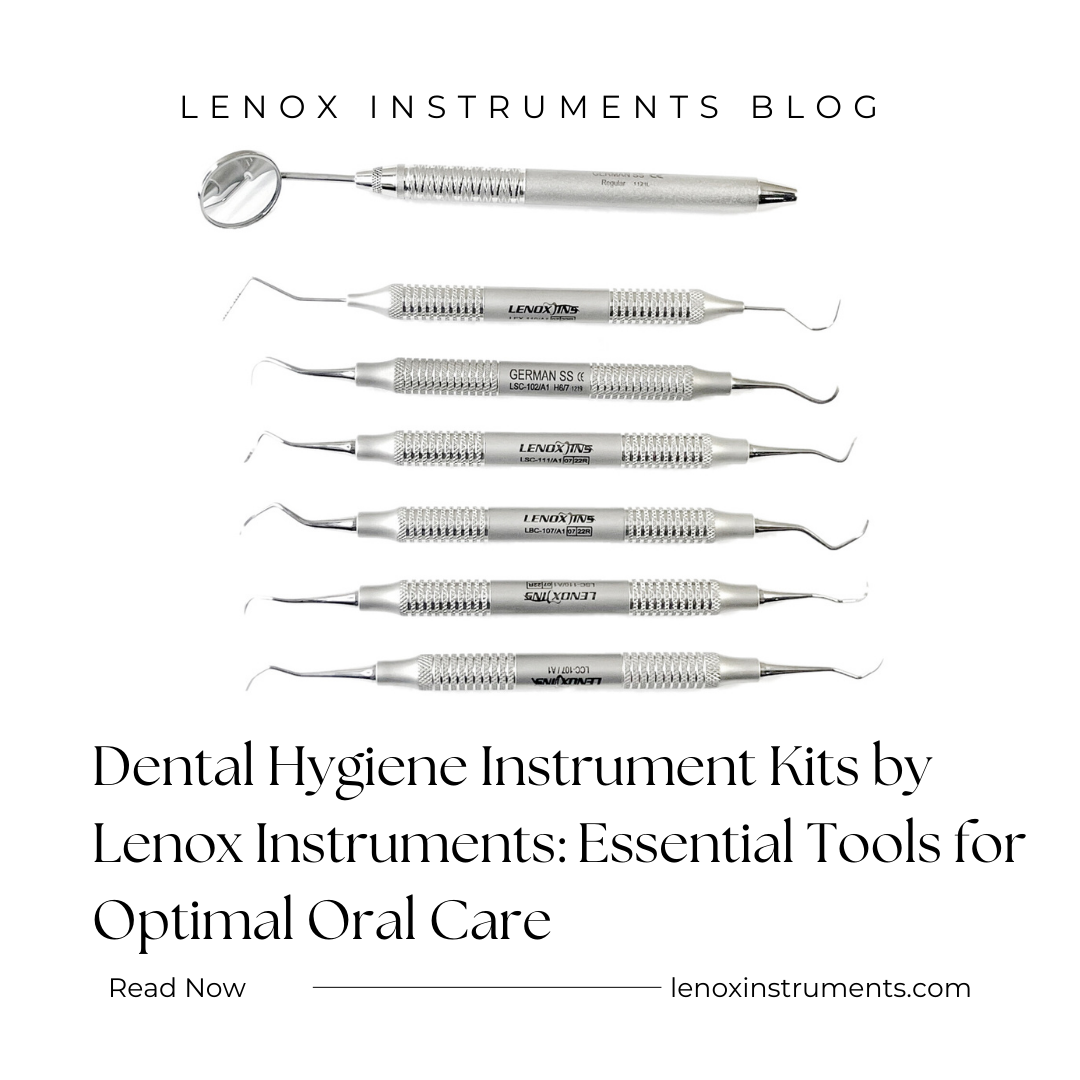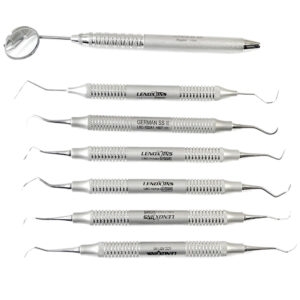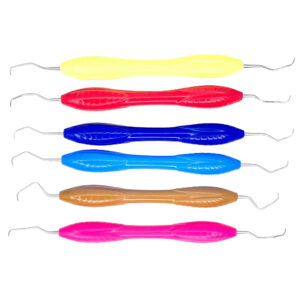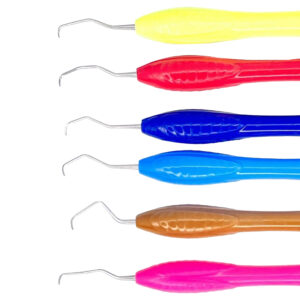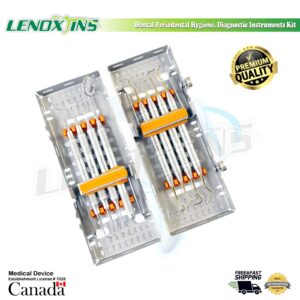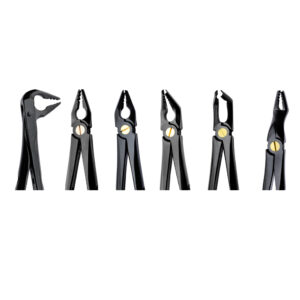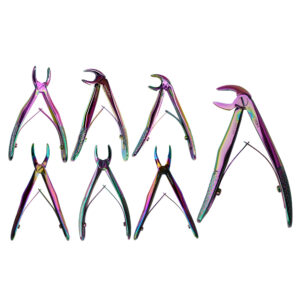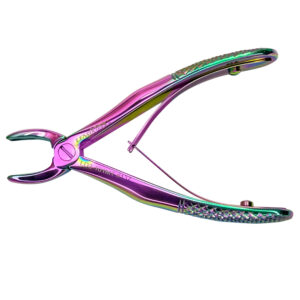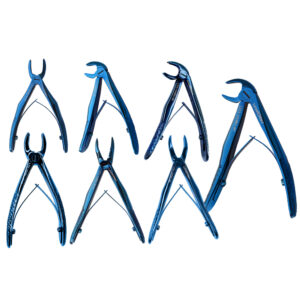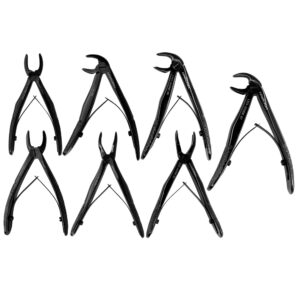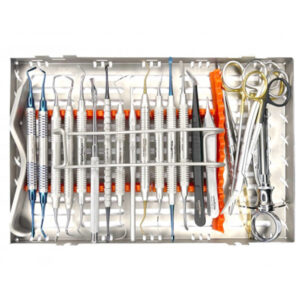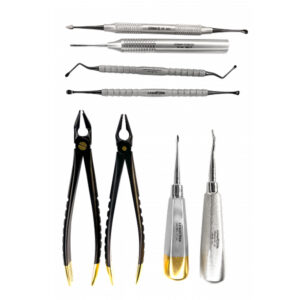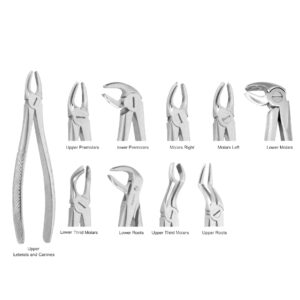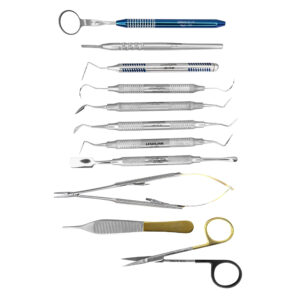Master Dental Care with the 204S Posterior Sickle Scaler
- Posted November 21, 2024
- by lenoxinstro
Dental professionals know the struggle: maintaining optimal oral health can be like navigating a tricky landscape. Enter the 204S Posterior Sickle Scaler, a precise tool that elevates routine cleanings to new heights. This article highlights key techniques for wielding the curette-like scaler and explores the significant benefits for both practitioners and patients. You’ll discover how proper care extends the instrument’s life and ensures that every dental dam and forceps intervention is more effective. Whether you’re seeking to refine your dental practice or improve patient satisfaction, the insights shared here about the 204S Posterior Sickle Scaler will help address common challenges in dental hygiene.
Understanding the Importance of Dental Hygiene
Good dental hygiene is pivotal for safeguarding overall health, as neglected oral care can have far-reaching consequences beyond just tooth decay. Cleaning hard-to-reach posterior teeth poses its own challenges, which is where specialized tools like the 204S posterior sickle scaler come into play. Crafted from durable materials such as titanium and stainless steel, this dental instrument is a vital component in endodontics, designed to meticulously remove plaque and calculus from the tooth surfaces that are otherwise difficult to maintain.
The Impact of Dental Hygiene on Overall Health
Maintaining a strict dental hygiene routine not only preserves a bright smile but also serves as the frontline defense against systemic health issues. Research shows a link between poor oral health and an increased risk for conditions like cardiovascular disease and diabetes, drawing attention to the necessity for meticulous care, particularly in difficult-to-clean areas. The use of precision tools such as the 204S posterior sickle scaler, made typically from high-quality stainless steel, assists in preventing the buildup of harmful bacteria that can compromise both dental and overall health.
Regular dental check-ups, complemented by proper home care, empower individuals to detect and manage potential health threats early. Dental professionals often recommend tools like the 204S posterior sickle scaler for optimal oral hygiene, as it is engineered to clear away plaque and tartar from tooth surfaces that evade standard cleaning. This attention to detail not only boosts oral health but can help mitigate the risk of associated systemic conditions, underscoring the importance of comprehensive dental care in maintaining general wellness.
Common Challenges in Cleaning Posterior Teeth
Reaching the back teeth, or molars, presents a unique hurdle in oral care due to their location and structure. The grooves and depressions of these posterior teeth harbor food particles and bacteria, making them prone to plaque accumulation and subsequent decay. Without adequate tools like the 204S posterior sickle scaler, effectively cleaning these areas is a challenge, potentially leading to gingivitis or more severe periodontal disease.
For many, the difficulty of maneuvering standard dental equipment around the curves of molars results in neglected hygiene in these critical zones. The 204S posterior sickle scaler, with its design tailored for accessibility and precision, becomes instrumental in overcoming this obstacle. Professionals leverage this tool to remove calcified deposits that regular brushing and flossing might miss, thus greatly enhancing the efficacy of dental maintenance routines and promoting sustained oral health.
Introducing the 204S Posterior Sickle Scaler
The 204S Posterior Sickle Scaler stands out in dental hygiene for its unique ability to enhance plaque removal on molar surfaces. This section will delve into the key features that distinguish the 204S design from other sickle scalers, highlighting how its precision engineering aids in combating plaque build-up. We will compare this tool’s effectiveness against alternatives, providing insights into why the 204S is the preferred choice for dental professionals seeking to optimize oral care. sickle scaler 204s
Key Features of the 204S Design
The 204S Posterior Sickle Scaler is distinguished by its slender, curved blade, designed specifically to navigate the contour of molar teeth with ease. Its sharpened tip allows dental professionals to adeptly target and remove stubborn plaque and tartar that are inaccessible with standard brushing, endearing this tool as a favorite for maintaining deep dental cleanliness. Sickle Scaler 204S
Constructed with high-grade stainless steel, this scaler exhibits superior durability and resistance to corrosion, ensuring longevity in a dental toolkit. The 204S‘s ergonomic handle affords practitioners better control and precision, minimizing fatigue and maximizing efficacy in plaque and calculus removal during oral hygiene procedures.
How the 204S Enhances Plaque Removal
The 204S Posterior Sickle Scaler excels in removing plaque from the molar areas due to its design tailored for the unique landscape of the back teeth. Its slender, curved blade is adept at reaching the pits and fissures that commonly harbor plaque accumulations, which are resistant to removal by regular brushing and flossing techniques. The strategic design of the 204S tool makes it indispensable for dental professionals aiming for thorough cleansing in these typically neglected regions.
When wielded by a skilled practitioner, the 204S Posterior Sickle Scaler becomes a precise instrument to combat the onset of gum disease. Its fine-tipped, meticulously sharpened edge targets the calculus build-up that threatens periodontal health, allowing for the effective preservation of the patient’s oral ecosystem. This precise control and capability to clear away plaque efficiently make the 204S a critical asset for maintaining optimal dental hygiene in clients.
Comparing the 204S to Other Sickle Scalers
The 204S Posterior Sickle Scaler stands out from its counterparts due to its specialized design tailored for the posterior teeth. Unlike other sickle scalers that may offer a generic curve, this tool features a more pronounced angle and a finer tip, enabling dental professionals to navigate the intricate grooves and crevices of molars with greater precision. This specific contouring allows for more effective plaque removal in areas that are notoriously difficult to clean with standard tools.
In comparison with other instruments used in dental practice, the 204S‘s uniquely hardened stainless steel composition provides a durability that resists wear. This means the tool maintains its sharpness over time, resulting in consistent performance and less frequent replacement. Dental practitioners appreciate the 204S not only for its ability to access tight spaces but also for its long-term reliability in removing calculus, thereby supporting optimal dental hygiene routines.
Techniques for Effective Use of the 204S Posterior Sickle Scaler
To maximize the benefits of the 204S Posterior Sickle Scaler in dental hygiene, understanding and applying the correct techniques are crucial. This includes mastering proper grip and hand positioning, executing optimal scaling motions for posterior teeth, ensuring patient comfort, and sidestepping common usage errors. Detailed discussion of these topics will equip dental professionals with valuable strategies for effective scaling, thereby enhancing patient outcomes and promoting sustained oral health.
Proper Grip and Hand Positioning
The proper grip and hand positioning are crucial for the effective use of the 204S Posterior Sickle Scaler, as they ensure precision in plaque removal while minimizing hand fatigue during dental procedures. A pinching grip, similar to holding a pen, allows for greater control over the instrument’s movements, critical when navigating the tight spaces of molar teeth. By adopting the right hold, dental professionals can enhance the efficacy of the scaler, targeting the build-up of tartar with accuracy and comfort.
Ensuring correct hand positioning further improves the maneuverability of the 204S Posterior Sickle Scaler, facilitating unimpeded access to the posterior regions of the mouth. The hand should be steady with the fingers positioned to allow gentle yet firm pressure, enabling the dental scaler to dislodge plaque effectively without causing undue discomfort to the patient. Such strategic positioning supports comprehensive dental care, advancing oral hygiene practices and patient satisfaction.
Optimal Scaling Motions for Posterior Teeth
Mastering the correct scaling motions for molars is vital when utilizing the 204S Posterior Sickle Scaler, as it ensures thorough plaque removal from these back teeth. The scaler should be handled with short, controlled strokes, adapting the pressure and angle for each patient’s unique dental topography. Dental professionals find that this targeted approach allows for optimal removal of calculus, leading to healthier gums and a reduced risk of periodontal disease.
For best results, the 204S Posterior Sickle Scaler must be moved coronally from the depths of each periodontal pocket, using an upward motion to effectively disrupt and clear plaque accumulations. This technique helps clinicians to maintain the integrity of the tooth enamel while thoroughly cleansing the posterior surface. Such precision in scaling directly contributes to the longevity of the patient’s dental health and exemplifies the merits of incorporating the 204S into routine dental maintenance.
Tips to Prevent Patient Discomfort
Alleviating patient discomfort during dental procedures with the 204S Posterior Sickle Scaler begins with effective communication. Dental practitioners should explain the steps of the procedure, ensuring that patients understand the importance of this tool in preventing gum disease and maintaining dental health. This awareness can ease anxiety, as patients appreciate the scaler’s role in enhancing their oral hygiene.
To further minimize discomfort, dental professionals should employ a gentle touch and frequent pauses when using the 204S Posterior Sickle Scaler. This approach allows the clinician to assess the patient’s comfort levels and adjust their technique as needed. Smooth, precise movements with the scaler not only reduce discomfort but also foster a more positive dental experience, encouraging patients to adhere to regular hygiene appointments.
Avoiding Common Mistakes With the 204S
A common challenge when using the 204S Posterior Sickle Scaler is applying excessive force, which can damage tooth enamel and irritate the gums. To avoid this, dental professionals should focus on using lighter, controlled strokes that effectively dislodge tartar without compromising the integrity of oral tissues. Employing a balance between gentle pressure and skillful technique is crucial for maximizing the effectiveness of the scaler while safeguarding patient comfort.
Another frequent oversight in the use of the 204S Posterior Sickle Scaler is overlooking the angulation, which is pivotal for optimal plaque removal from molar surfaces. A precise angulation of the instrument enhances accessibility to all areas, particularly the distal surfaces of the last molars. Dental practitioners can improve their technique by ensuring the scaler’s blade is appropriately adapted to the tooth’s curvature, thus enhancing the thoroughness of the cleaning process.
Benefits of the 204S Posterior Sickle Scaler in Dental Practice
The 204S Posterior Sickle Scaler is a key instrument in enhancing dental hygiene practices, with distinct benefits that address common clinical challenges. Its design markedly increases scaling efficiency, allowing dental professionals to access challenging areas with ease. Additionally, the ergonomic handle of the 204S reduces clinician fatigue, which can be key during longer procedures. These features collectively contribute to more effective plaque removal, making the scaler an invaluable tool in dental care.
Increasing Scaling Efficiency
The 204S Posterior Sickle Scaler is instrumental in improving the efficiency of dental scaling, particularly in hard-to-reach molar areas. Its design minimizes the time needed to remove plaque and tartar build-up, directly enhancing patient outcomes and practice productivity. Dental professionals appreciate the scaler’s ability to navigate the landscape of the back teeth with precision, streamlining the cleaning process and reducing the overall duration of dental appointments.
This specialized tool’s sharp, angled blade is pivotal in swiftly and effectively dislodging stubborn deposits that could lead to cavities or gum disease. By facilitating quicker, more thorough cleanings, the 204S Posterior Sickle Scaler not only elevates the standard of care but also allows dental practitioners to serve more patients with consistent, high-quality results. Consequently, incorporating this scaler into routine dental maintenance is a strategic choice for practitioners looking to optimize their operations while prioritizing patient dental health.
Reaching Challenging Areas With Ease
The 204S Posterior Sickle Scaler is expressly designed to improve access to the posterior dental regions that are notoriously difficult to clean. Its finely honed tip and tailored angle allow dental practitioners to effectively navigate and dislodge plaque in these secluded areas, ensuring comprehensive oral hygiene and reducing the potential for decay and gum disease.
By facilitating the removal of tartar deposits from the crevices of molars and the interdental spaces that other instruments might miss, the 204S Posterior Sickle Scaler becomes a cornerstone of preventive dental care. Its precision not only leads to a deeper clean but also enhances patient comfort, aiding professionals in achieving optimal results in dental maintenance.
Reducing Clinician Fatigue Through Ergonomic Design
The ergonomic design of the 204S Posterior Sickle Scaler plays a significant role in diminishing clinician fatigue. Its handle, tailored for comfort, enables dental practitioners to maintain a natural grip throughout extended periods of use, reducing strain on the fingers and wrists. This design consideration fosters prolonged performance precision, crucial for detailed plaque removal in posterior teeth. Sickle Scaler 204S
Enhanced control means less exertion is needed to achieve desired results with the 204S Posterior Sickle Scaler. The tool is balanced to provide an intuitive feel, which lessens the need for forceful movements that can lead to hand fatigue and repetitive stress injuries. In this way, the 204S scaler represents an advancement in dental instruments, merging functionality with practitioner welfare.
Maintaining and Caring for Your 204S Posterior Sickle Scaler
To ensure the 204S Posterior Sickle Scaler remains a cornerstone in dental hygiene practices, appropriate maintenance is crucial. Effective sterilization practices not only adhere to health and safety standards but also prolong the sharpness and effectiveness of the scaler. Regular sharpening maintains the scaler’s precision, while proper storage extends the lifespan of the instrument. Upcoming sections will delve into the specifics of each of these areas, providing dental professionals with the know-how to manage their tools efficiently and sustain top-tier care for their patients.
Best Practices for Sterilization
Proper sterilization of the 204S Posterior Sickle Scaler is essential to prevent cross-contamination and maintain a hygienic dental practice. Dental professionals should follow a sterilization protocol that includes thoroughly washing the instrument with water and detergent, drying it completely, and then subjecting it to an autoclave cycle at the appropriate temperature and pressure as recommended by the manufacturer. This process ensures that the scaler is free from bacteria, viruses, and other pathogens before its next use.
To maintain the integrity and sharpness of the 204S Posterior Sickle Scaler, the sterilization technique should be complemented by careful handling. Instruments must be arranged in a manner that prevents contact with one another during the sterilization cycle to avoid damage. Following these best practices for sterilization safeguards both patient and clinician health, and extends the functional lifespan of the 204S scaler, thereby upholding the standard of oral care.
Effective Sharpening Methods
Sharpening the 204S Posterior Sickle Scaler is a delicate process that preserves the tool’s efficacy. Dental professionals apply a fine sharpening stone to the scaler’s blade, maintaining the original angle to keep its contour precise. Regular sharpening enhances the scaler’s ability to remove plaque effectively, ensuring peak performance and extending the instrument’s service life.
For the sharpening protocol to be successful, it should occur under good lighting and with a steady hand to maintain the scaler’s integrity. Clinicians often use magnification to spot any wear or dullness, addressing these areas with meticulous strokes. Through this precision-led approach, the 204S Posterior Sickle Scaler remains a potent ally in dental hygiene, enabling optimal care for patients.
Proper Storage to Extend Instrument Life
Storing the 204S Posterior Sickle Scaler correctly is essential to its longevity in a dental practice. After sterilization, the scaler should be placed in a designated instrument cassette or holder where it’s protected from contact with other tools, preventing premature dulling or damage to its fine-tipped edge. This careful storage protects the investment in quality instruments and ensures they are ready for efficient plaque removal during patient care.
Dental professionals realize the importance of maintaining an organized workspace where tools like the 204S scaler are easily reachable yet securely stored. A dry environment prevents corrosion, and dedicated storage mitigates the chance of accidental drops or mishandling, sustaining the instrument’s effectiveness in dental hygiene procedures. Careful storage directly contributes to the reliability and performance of the sickle scaler, thereby maximizing the standard of oral care provided to patients.
Enhancing Patient Outcomes With the 204S Posterior Sickle Scaler
Securing optimal dental health outcomes hinges on the integration of advanced tools and patient education. The 204S Posterior Sickle Scaler emerges as a key component in this process, offering tangible benefits discussed in the ensuing sections. Here, we illuminate the significance of educating patients on scaling’s urgency, share success stories underscoring the 204S‘s effectiveness, and explore the seamless incorporation of this precise tool into routine hygiene appointments. Collectively, these insights reflect the scaler’s pivotal role in elevating patient care and dental hygiene standards.
Educating Patients on the Importance of Scaling
Informing patients about the essential role of scaling in dental hygiene is crucial in the fight against periodontal disease. When dental professionals highlight the 204S Posterior Sickle Scaler’s effectiveness in removing plaque from difficult posterior teeth, patients are more likely to understand its significance. This understanding fosters greater acceptance of the scaler as a necessary component of their oral health routine, leading to more frequent and successful scaling appointments.
Real-world outcomes demonstrate that patients who are knowledgeable about scaling and its benefits tend to maintain better oral hygiene between visits. By showing patients the tangible results achieved with the 204S Posterior Sickle Scaler, such as reduced gum inflammation and decreased plaque buildup, dentists can boost compliance and encourage proactive oral healthcare practices.
Success Stories Using the 204S
Clinical success stories with the use of the 204S Posterior Sickle Scaler reinforce its value in dental practices. One notable instance involves a patient with a history of periodontal issues who had struggled with recurrent plaque build-up in the molar region. After incorporating the 204S scaler into their oral hygiene regimen, subsequent visits revealed improved gum health and a significant reduction in tartar accumulation, a testament to the scaler’s proficiency in accessing and cleaning challenging areas.
Another case highlights the positive impact on a patient’s oral hygiene following the introduction of the 204S scaler during routine cleanings. The patient, who was prone to cavities and gum inflammation despite diligent oral care, experienced a noticeable improvement in overall dental health. The meticulous removal of plaque from the posterior teeth using the specialized scaler not only enhanced the health of the gums but also contributed to a decline in the formation of new cavities, showcasing the effectiveness of tailored dental tools in patient care.
Integrating the 204S Into Regular Hygiene Appointments
Incorporating the 204S Posterior Sickle Scaler into routine hygiene appointments is a strategic move that enhances patient care and supports the comprehensive removal of plaque, particularly in the molar areas. When dental professionals consistently utilize this precise tool, they ensure that each cleaning session thoroughly addresses the build-up of tartar and bacteria responsible for oral health complications. Regular use of the 204S scaler facilitates meticulous care, catering to the unique needs of each patient’s dental anatomy.
By making the 204S Posterior Sickle Scaler a staple in preventive care, dental practitioners can elevate the standard of hygiene treatments while minimizing the likelihood of periodontal disease and dental decay. This integration not only optimizes the outcome of each appointment but also underscores the dental practice’s commitment to innovative care techniques. Patients benefit from knowing that their dental health is maintained using advanced tools and methods specifically designed to safeguard their oral well-being.
Conclusion
The 204S Posterior Sickle Scaler emerges as an invaluable tool in dental hygiene, adeptly tackling the challenge of plaque removal in hard-to-reach molar areas and mitigating the risk of periodontal disease. Its ergonomic design and precise angulation increase the efficiency of dental cleanings, significantly improving patient outcomes while decreasing clinician fatigue. By integrating this specialized scaler into routine care, dental professionals can ensure a comprehensive clean, fulfilling their commitment to advanced patient health practices. The 204S Posterior Sickle Scaler’s role is instrumental, advancing oral health maintenance to new levels of effectiveness and reliability.

